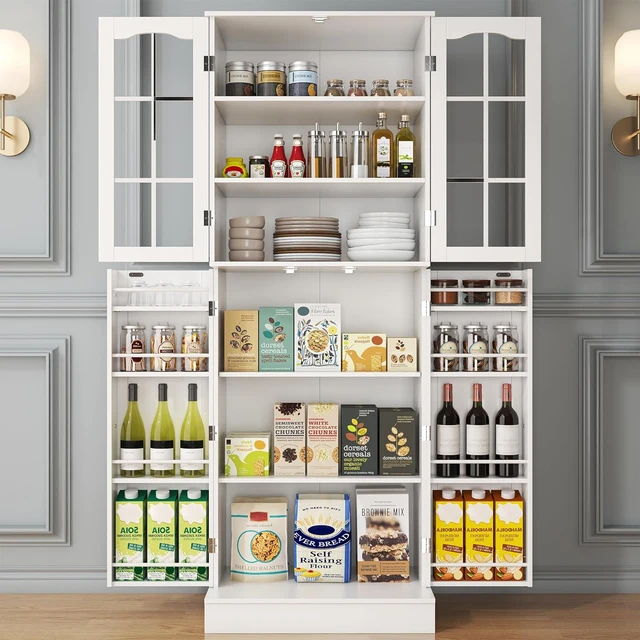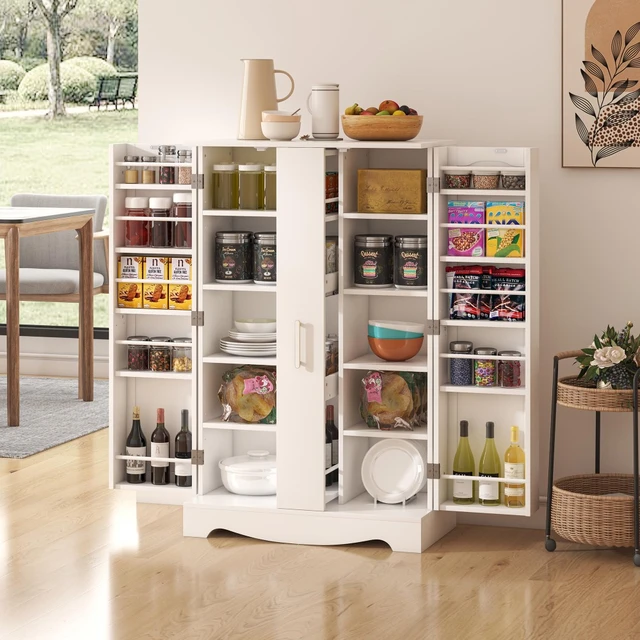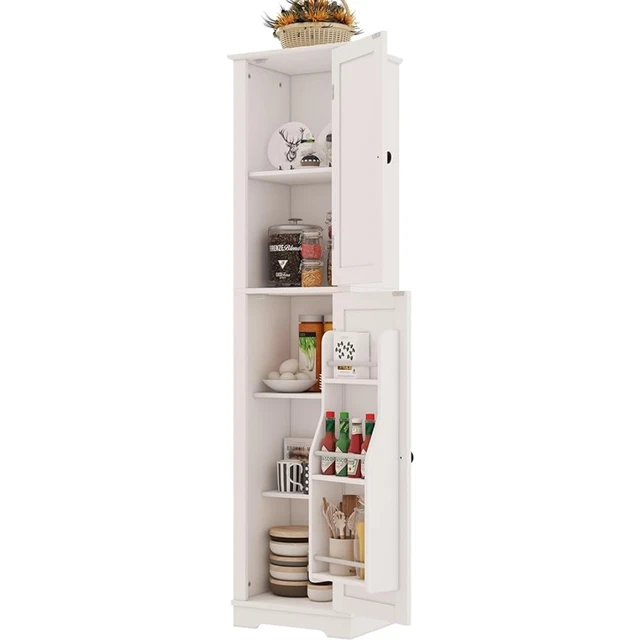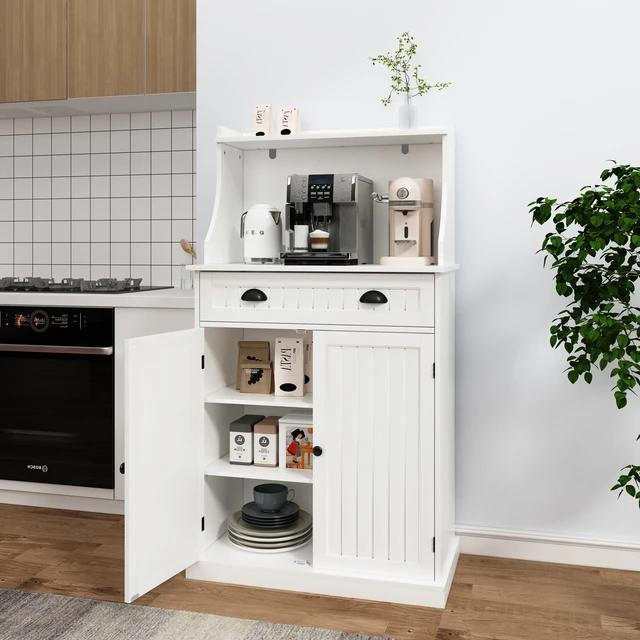 Introduction:
Introduction:
A kitchen pantry cabinet is an essential element in any kitchen for organizing and storing food, supplies, and kitchen essentials. A freestanding pantry cabinet offers the flexibility of placement and additional storage space without the need for built-in cabinetry. In this comprehensive guide, we will explore the features, benefits, and considerations when choosing a freestanding kitchen pantry cabinet. From different styles and materials to organization tips and placement options, we will cover everything you need to know to make an informed decision and enhance the functionality and aesthetics of your kitchen.
Benefits of a Freestanding Kitchen Pantry Cabinet:
Additional Storage Space:
A freestanding pantry cabinet provides additional storage space for food items, kitchen supplies, and small appliances.
It helps declutter the kitchen countertops and cabinets, creating a more organized and efficient space.
Flexibility and Portability:
Unlike built-in pantry cabinets, freestanding ones offer the flexibility of placement and easy repositioning.
You can move the cabinet to different areas of the kitchen or even to another room if needed.
Stylish Design Options:
Freestanding pantry cabinets come in various designs, styles, and finishes, allowing you to choose one that complements your kitchen decor.
They can add a touch of elegance and sophistication to the overall aesthetic of your kitchen.
 Considerations When Choosing a Freestanding Kitchen Pantry Cabinet:
Considerations When Choosing a Freestanding Kitchen Pantry Cabinet:
Size and Capacity:
Measure the available space in your kitchen to determine the appropriate size and capacity of the pantry cabinet.
Consider your storage needs and the types of items you plan to store in the cabinet.
Design and Style:
Choose a freestanding pantry cabinet that matches the design and style of your kitchen.
Options include traditional, modern, rustic, or industrial styles to suit your personal taste and kitchen decor.
Material and Durability:
Consider the material used for the pantry cabinet, such as wood, metal, or composite materials.
Opt for a durable and sturdy option that can withstand the weight of stored items and daily use.
Shelving and Organization:
Look for a pantry cabinet with adjustable shelves to customize the storage space according to your needs.
Consider additional organization features such as drawers, spice racks, or wine racks for enhanced functionality.
 Organization Tips for a Freestanding Kitchen Pantry Cabinet:
Organization Tips for a Freestanding Kitchen Pantry Cabinet:
Categorize and Group Items:
Group similar items together, such as canned goods, dry goods, spices, or snacks.
This makes it easier to locate items and maintain an organized pantry.
Utilize Storage Containers and Baskets:
Use storage containers or baskets to corral small items and keep them organized within the pantry cabinet.
Label the containers for easy identification and accessibility.
Store Frequently Used Items Within Reach:
Place frequently used items on lower shelves or within easy reach for convenience.
Reserve higher shelves for less frequently used items or seasonal items.
Maximize Vertical Space:
Utilize the vertical space within the pantry cabinet by using stackable bins or adjustable shelving.
This allows for efficient use of space and accommodates items of various sizes.
Placement Options for a Freestanding Kitchen Pantry Cabinet:
Against a Wall:
Place the pantry cabinet against a wall to optimize space and create a dedicated storage area within the kitchen.
Ensure there is enough clearance for opening and closing the cabinet doors.
In a Corner:
Utilize a corner of the kitchen by placing the pantry cabinet in that area.
Corner placement maximizes space usage and creates a visually pleasing design element.
Integrated with Other Furniture:
Integrate the freestanding pantry cabinet with other kitchen furniture, such as an island or a baker’s rack.
This creates a cohesive and functional storage area within the kitchen.
Maintenance and Care:
Regular Cleaning:
Clean the pantry cabinet regularly to prevent dust, dirt, or spills from accumulating.
Use a damp cloth and mild cleaning solution to wipe down the surfaces.
Organized Inventory:
Regularly check the contents of the pantry cabinet and discard expired or unused items.
This ensures an organized and clutter-free space.
 To replace a kitchen pantry cabinet, follow these steps:
To replace a kitchen pantry cabinet, follow these steps:
Measure and Plan:
Measure the dimensions of the existing pantry cabinet and ensure that the new cabinet you choose will fit in the available space. Consider the height, width, and depth of the cabinet, as well as any additional requirements such as shelving or drawer space.
Empty the Cabinet:
Remove all items from the existing pantry cabinet and transfer them to a temporary storage area. This will make it easier to work on the cabinet.
Disconnect Utilities:
If there are any electrical or plumbing connections, such as lighting fixtures or water lines, make sure to turn off the power or shut off the water supply. If necessary, seek professional assistance for disconnecting these utilities.
Unscrew or Remove the Cabinet:
Carefully unscrew or remove any screws or fasteners that secure the pantry cabinet to the wall or surrounding cabinets. Use a screwdriver or power drill, as needed. Have someone assist you in holding the cabinet to prevent it from falling during removal.
Remove Trim or Molding:
If there is any trim or molding around the cabinet, carefully remove it using a pry bar or a similar tool. Take care not to damage the surrounding walls or cabinets.
Prepare the Area:
Clean the space where the old cabinet was situated, removing any debris or dirt. If necessary, touch up the paint or repair any damage to the walls.
Install the New Cabinet:
Position the new pantry cabinet in the desired location and ensure it is level. Secure the cabinet to the wall or surrounding cabinets using appropriate screws or fasteners. Follow the manufacturer’s instructions for installation, as cabinet installation methods may vary.
Reconnect Utilities:
If there were any electrical or plumbing connections, reconnect them according to the manufacturer’s instructions or seek professional assistance if needed. Ensure that everything is properly connected and working before proceeding.
Add Trim or Molding:
If desired, install trim or molding around the new cabinet to enhance its appearance and provide a finished look. Use appropriate tools and techniques to attach the trim securely.
Arrange and Organize:
Once the new pantry cabinet is installed, transfer the items back into the cabinet and organize them according to your preference. Consider using storage bins, baskets, or shelf organizers to maximize space and improve organization.
Replacing a kitchen pantry cabinet may require some DIY skills and tools. If you are uncertain or uncomfortable with the process, it is recommended to seek assistance from a professional contractor or carpenter who can ensure proper installation and safety.
 Conclusion:
Conclusion:
A freestanding kitchen pantry cabinet offers functionality, additional storage space, and a stylish design element to your kitchen. By considering factors such as size, design, material, and organization, you can choose a pantry cabinet that meets your specific needs. Implement organization tips, utilize storage containers, and optimize placement options to make the most of your pantry cabinet.Such as placing plates, vases, time lock, etc. With proper maintenance and care, your freestanding pantry cabinet will enhance the functionality and aesthetics of your kitchen while providing efficient storage for all your kitchen essentials.


